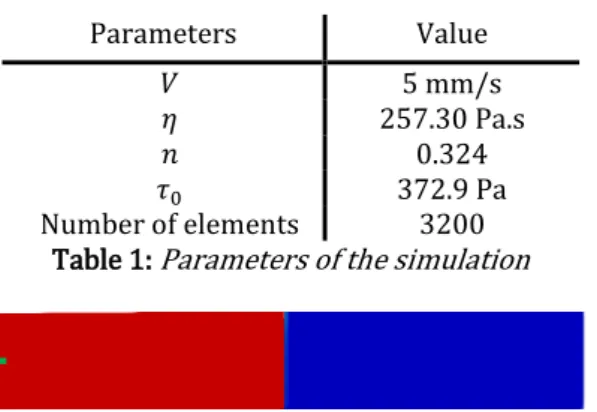HAL Id: hal-02057725
https://hal-mines-albi.archives-ouvertes.fr/hal-02057725
Submitted on 5 Mar 2019
HAL is a multi-disciplinary open access
archive for the deposit and dissemination of
sci-entific research documents, whether they are
pub-lished or not. The documents may come from
teaching and research institutions in France or
abroad, or from public or private research centers.
L’archive ouverte pluridisciplinaire HAL, est
destinée au dépôt et à la diffusion de documents
scientifiques de niveau recherche, publiés ou non,
émanant des établissements d’enseignement et de
recherche français ou étrangers, des laboratoires
publics ou privés.
Modelling the shape of an adhesive joint during
assembly
William Han, Florentin Berthet, Gilles Dusserre, Fabrice Schmidt
To cite this version:
William Han, Florentin Berthet, Gilles Dusserre, Fabrice Schmidt. Modelling the shape of an adhesive
joint during assembly. ICSAAM 2018 - The 8th International Conference on Structural Analysis of
Advanced Materials, Aug 2018, Tarbes, France. �hal-02057725�
Modelling the shape of an adhesive joint during
assembly
William Han
1, Florentin Berthet
1, Gilles Dusserre
1and Fabrice Schmidt
11Université de Toulouse ; IMT Mines Albi, ICA (Institut Clément Ader) ; Campus Jarlard, F-81013, Albi cedex 09, France.
Abstract
he use of structural adhesive bonding has increased in recent years for its comparatively superior properties. Recent advances in the technology aims to offer industrials a reliable process for bonding assemblies. One part of this project implies to simulate the shape of the adhesive, at the end of the docking process, which will be done using the Volume of Fluid method (VOF) implemented in OpenFoam®, an open source CFD toolbox. In order to validate, the numerical
model is then compared to analytical solutions for cylindrical models and will be further extended to more complex geometries.
Keywords: Process simulation, modelling, non-linear behavior, adhesive, Computational Fluid Dynamics, Volume of Fluid, Herschel-Bulkley
1. Introduction
The use of adhesives in structural assemblies has gained more and more interest in recent years as adhesive joints can have a better strength to weight ratio than traditional mechanical fasteners, especially when used for dissimilar materials such as metals and composite. Moreover, adhesives benefited from recent advances in other fields such as chemistry which brought new, multi-components and nanostructured polymers. However industrial applications are inhibited as the technology lacks maturity: for instance the mechanical properties of the joint are heavily impacted by the thickness and the shape of the joint. The project S3PAC (Simulation and Supervision System for bonded Assembly Production) has been launched in this context. In this work, a computational fluid dynamic model is proposed in order to predict the flow from an initial deposition of a SAF30MIB adhesive bond manufactured by AEC polymers/Bostik shown Figure 1 [1].
Figure 1 : Initial deposition of the adhesive cords
2. Methodology
The shape of the adhesive can be numerically computed using finite volume calculations and a volume of fluid (VOF) method for multiphase simulations implemented in OpenFOAM®, an open source CFD toolbox [2], where the calculations for the flow of the adhesive is coupled with those of the air using the incompressible and momentum equations:
Proposed template for the ICSAAM 2018 Conference in Tarbes
∇𝒖 = 0 (1)
𝜌 (𝜕𝑢
𝜕𝑥+ 𝒖 ∙ ∇𝒖) = −∇𝑝 + ∇τ
(2)
with 𝜌 the density, 𝒖 the velocity vector, 𝑝 the pressure and the shear stress tensor.
The interface is then given through the mean of a volume fraction equation between both phases, adhesive and air. In order to assess the quality of a computed model, the pressure distribution and thus the forces applied to the adhesive can be compared to an analytical solution of a fluid submitted to squeeze-flow. They are usually found in the literature for cylindrical samples [3] but for non-Newtonian fluids, they can be generalized for random shapes using the contact surface between the adhesive and the substrate as a parameter [4].
The constitutive behavior used for the adhesive follows a Herschel-Bulkley model, which, in the scalar form is given by:
𝜏 = 𝜏0+ 𝜂𝛾̇𝑛 (3)
with 𝜏0 the yield shear stress, 𝛾̇the shear rate, n the power-law exponent and 𝜂the dynamic viscosity. For an
axisymmetric cylindrical piece of adhesive compressed between two parallel plates, under no-slip wall boundary condition and following a lubrication approximation, the pressure distribution can be obtained with the following expression [5]: 𝑝(𝑟) = 𝜎0+ 2 𝜏0 ℎ [ 𝑅 − 𝑟 + ( 2𝑛 + 1 𝑛 ) 𝑛 (𝑅 𝑛+1− 𝑟𝑛+1 𝑛 + 1 ) ( 𝑉𝜂1/𝑛 ℎ2𝜏 01/𝑛 ) 𝑛 ] (4)
where V is the velocity of the upper plate if the lower plate is motionless, ℎ the plate distance, 𝑅 the radius of the adhesive and 𝜎0 the uniaxial yield stress, defined as 𝜎0= √3𝜏0 for a Von Mises solid.
3. Preliminary results and discussion
Numerical simulations have been performed using a quasi-2D (one element thick) axisymmetric model of a squeeze-flow with an orthogonal mesh composed of wedge and hexahedral elements, shown Figure 1, at constant velocity with the values of the parameters listed in Table 1. The rheological parameters of the adhesive are taken from Bergamasco et al. [4].
Parameters Value 𝑉 5 mm/s 𝜂 257.30 Pa.s 𝑛 0.324 𝜏0 372.9 Pa Number of elements 3200 Table 1: Parameters of the simulation
Figure 2: Initial state of the cylindrical squeeze-flow model, with the position of the pressure results shown Figure 3 indicated by a cross.
Results for the pressure versus the distance between the plates at the center of the adhesive are reported below in Figure 1. Comparisons show fair agreement between the analytical and the numerical model.
Proposed template for the ICSAAM 2018 Conference in Tarbes
Figure 3: Comparison of analytical and numerical solutions for a squeeze-flow test at constant velocity (left), relative error expressed as |panalytical – pnumerical|/panalytical (right)
Other geometries will be then simulated, for example, the Figure 4 below shows a quasi-2D model, with a hexahedral orthogonal meshing of 16000 elements modelling two adhesive cords being compressed. It shows that air can be trapped both between and below the adhesives cords.
Figure 4 : Flow of two adhesive cords (red phase) in the air (blue phase) with VOF tracking of the surface at different times of the compression
4. Conclusion and future work
3D geometries describing the initial repartition of the adhesive cords in the process will be studied in order to be able to accurately predict its shape for industrial use. Then a time and space dependent rheological model will be used in order to better take into account other key parameters in the behavior of the considered material, the SAF 30MIB, such as its polymerization occurring during both its application on the lower substrate and the assembly process.
Acknowledgments
This work was supported by national FUI project S3PAC (Simulation and Supervision System for bonded Assembly Production), co-funded by BPI France, the Occitanie region and the Nouvelle Aquitaine region.
References
[1] F. Berthet, Projet S3PAC, Rapport: Caractérisation matériaux. Internal report, 2017.
[2] H. Rusche, Computational fluid dynamics of dispersed two-phase flows at high phase fractions. PhD Thesis, Imperial College London, 2002.
[3] J. Engmann, C. Servais, A. S. Burbidge, Squeeze flow theory and applications to rheometry : A review. Journal of Non-Newtonian Fluid Mechanics, 2005;132(13):1-27.
[4] L. Bergamasco, S. Izquierdo , E. Duvivier, J.M. Royo, A. Chiminelli, M.A. Jiménez, Generalized analytical solution for compressive forces in adhesively-bonded-joint assembling. International Journal of Adhesion & Adhesives, 2014;52:26–30.
[5] M.J.Adams, B.Edmondson, D.G.Caughey, R.Yahya, An experimental and theoretical study of the squeeze-film deformation and flow of elastoplastic fluids. Journal of Non-Newtonian Fluid Mechanics, 1994;51(1):61–78.


